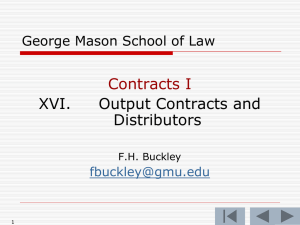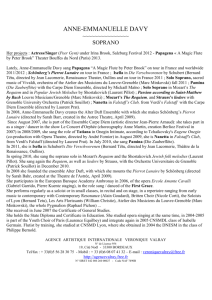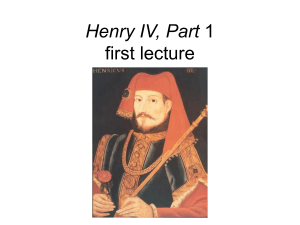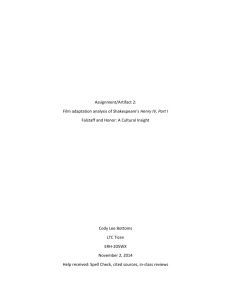O. Output Contracts and Distributors
advertisement
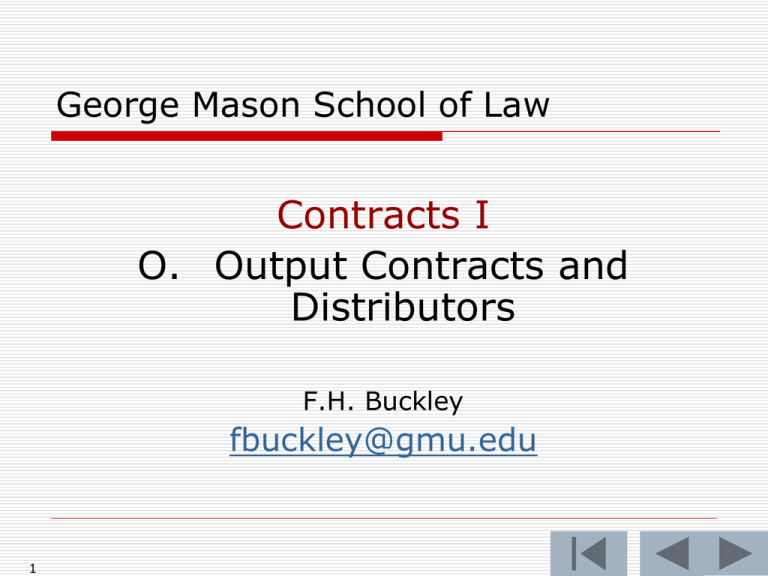
George Mason School of Law Contracts I O. Output Contracts and Distributors F.H. Buckley fbuckley@gmu.edu 1 Output and Requirements contracts UCC § 2-306(1) A term which measures the quantity by the output of the seller or the requirements of the buyer means such actual output or requirements as may occur in good faith, except that no quantity unreasonably disproportionate to any stated estimate or in the absence of a stated estimate to any normal or otherwise comparable prior output or requirements may be tendered or demanded. 2 Requirements Contracts Requirements contract: producer agrees to sell as much of his product as buyer requires 3 Requirements Contracts Requirements contract: producer agrees to sell as much of his product as buyer requires Strategic behavior: misincentives as to quantity 4 Requirements Contracts and Incentives as to Quantity Contract Price > Market Price 5 Market Price > Contract Price Supplier Gulf undersupplies Buyer Eastern Air Lines overconsumes Requirements Contracts and Incentives Contract Price > Market Price 6 Supplier Empire Gas Empire Gas Over-supplies Buyer American Bakeries American Bakeries underconsumes Market Price > Contract Price Output Contracts Output contract: buyer agrees to purchase seller’s entire output 7 Output Contracts Buyer agrees to buy all of producer’s output Risks to buyer: 8 Output Contracts Buyer agrees to buy all of producer’s output Risks to buyer: What if market price < contract price 9 Output Contracts Buyer agrees to buy all of producer’s output Risks to buyer: What if market price < contract price What if buyer can’t use the output Weak demand for buyer’s product Higher costs for buyer 10 Output Contracts Buyer agrees to buy all of producer’s output Risks to seller: 11 Output Contracts Buyer agrees to buy all of producer’s output Risks to seller: What if market price > contract price 12 Output Contracts Buyer agrees to buy all of producer’s output Risks to seller: What if market price > contract price What if seller’s cost > contract price 13 Price Changes: Output Contracts Assuming that Contract Price > Market Price Contract Price > Market Price Supplier Buyer 14 Market Price > Contract Price Price Changes: Output Contracts Assuming that Contract Price > Market Price Contract Price > Market Price Supplier Buyer 15 Market Price > Contract Price Price Changes: Output Contracts Assuming that Contract Price > Market Price Contract Price > Market Price Supplier Buyer 16 Woo-hoo!!!! Market Price > Contract Price Price Changes: Output Contracts Assuming that Contract Price > Market Price Contract Price > Market Price Supplier Buyer 17 Wants out Market Price > Contract Price Price Changes: Output Contracts Assuming that Market Price > Contract Price Contract Price > Market Price Supplier Buyer 18 Market Price > Contract Price Price Changes: Output Contracts Assuming that Market Price > Contract Price Contract Price > Market Price Supplier Buyer 19 Market Price > Contract Price Wants out Price Changes: Output Contracts Assuming that Market Price < Contract Price Contract Price > Market Price Market Price > Contract Price Supplier Buyer 20 Woo-hoo!!!! Price Changes: Output Contracts Assuming that Market Price < Contract Price 21 Contract Price > Market Price Market Price > Contract Price Supplier Woo-hoo!!!! Wants out Buyer Wants out Woo-hoo!!!! What if Seller’s Costs Increase? Contract Price > Cost Supplier Buyer 22 Cost > Contract Price Output Contracts Cost to Seller Contract Price > Cost Supplier Buyer 23 Cost > Contract Price Wants out Output Contracts: Feld v. Levy p. 332 Bakery Levy 24 Bread crumbs Distributor Feld Output Contracts: Feld v. Levy A renewable one-year contract in which Levy agrees to sell all its bread crumbs to Feld for $1/lb. Feld thinks he can resell at $1.50/lb. 25 Output Contracts: Feld v. Levy A renewable one-year contract in which Levy agrees to sell all its bread crumbs to Feld Levy discovers that the marginal cost ($1.06) exceeds the contract price ($1.00) and cancels 26 Output Contracts: Feld v. Levy Held: It would be bad faith for Levy to stop crumb production just because their profits aren't as high as they expected, but it would be good faith for Levy to stop crumb production if they incurred losses from such production that were "more than trivial". 27 Output Contracts: Feld v. Levy See excerpt on 345 28 Output Contracts: Feld v. Levy Does it make sense to require the baker to lose money? 29 Output Contracts: Feld v. Levy Does it make sense to require the baker to lose money? Is there something troubling about the numbers? 30 Output Contracts: Feld v. Levy 31 Output Contracts: Feld v. Levy What if the baker could sell elsewhere for $1.20 Do you think this might do something to his reported costs, if this affords him an out? 32 Output Contracts: Feld v. Levy What if the cost of production is now $1.50? 33 Output Contracts: Feld v. Levy 34 Output Contracts: Feld v. Levy How is this case like Empire Gas? 35 Output Contracts: Feld v. Levy Can a buyer in a requirements contract purchase zero quantities? Empire Gas 36 Output Contracts: Feld v. Levy Can a buyer in a requirements contract purchase zero quantities? Empire Gas Can a seller in an output contract sell zero quantities? Feld v. Levy 37 Output contracts Good faith standards imposed in both cases 38 Exclusive Dealing Wood v. Duff-Gordon p. 341 Lady Duff Gordon 39 Exclusive Dealing Wood v. Duff-Gordon Wood to have the exclusive right to market her clothes or endorsements In return to receive one-half of all “profits and revenues” One year term, renewable unless cancelled on 90 days notice 40 Exclusive Dealing Wood v. Duff-Gordon Is this a binding contract? 41 Exclusive Dealing Wood v. Duff-Gordon Is this a binding contract? Is it too uncertain? What’s missing? 42 Exclusive Dealing Wood v. Duff-Gordon Is this a binding contract? Is it too uncertain? Does it lack consideration? 43 Exclusive Dealing Wood v. Duff-Gordon Is this a binding contract? Cardozo: decries a “primitive age of formalism” What is the canonical take-away? 44 Exclusive Dealing Wood v. Duff-Gordon Is this a binding contract? Finds “an instinct with an obligation” imperfectly expressed to use reasonable efforts The Moorcock: Bowen L.J.: imply a term to give business efficacy to an agreement 45 Exclusive Dealing Wood v. Duff-Gordon What is the economic rationale for finding a binding contract here? 46 Exclusive Dealing Wood v. Duff-Gordon What is the economic rationale for implying duties by the distributor? Consider Wood’s incentive to make contract-specific investments absent a binding contract 47 Exclusive Dealing Wood v. Duff-Gordon How would you formulate the duties of the parties, as a matter of legal drafting? 48 Exclusive Dealing Wood v. Duff-Gordon How would you formulate the duties of the parties, as a matter of legal drafting? Good faith by Duff-Gordon Best efforts by both 49 Exclusive Dealing Wood v. Duff-Gordon UCC § 2-205. Every contract imposes upon each party a duty of good faith and fair dealing in its performance and enforcement." 50 Exclusive Dealing Wood v. Duff-Gordon UCC § 2-306(2) A lawful agreement by either the seller or the buyer for exclusive dealing in the kind of goods concerned imposes unless otherwise agreed an obligation by the seller to use best efforts to supply the goods and by the buyer to use best efforts to promote their sale. 51 What are Good Faith Standards Van Valkenburgh p. 354 52 What are Good Faith Standards Van Valkenburgh p. 354 Just where did the publisher cross the line? 53 What are Good Faith Standards Van Valkenburgh p. 354 What is the answer to the query at the bottom of 354? 54 What is best efforts? Bloor v. Falstaff 343 55 Bloor v. Falstaff 56 Bloor v. Falstaff 57 Bloor v. Falstaff What was the deal? Judge Charly Brieant 58 Bloor v. Falstaff Falstaff buys all Ballantine assets except the brewery for $4M plus a royalty of 50 cents on each barrel of Ballantine sold over a 6 yr. period Buyer to use best efforts to promote and maintain a high volume of sales Buyer to pay up to $1.1M if it substantially discontinues selling Ballantine 59 Bloor v. Falstaff Why structure it that way? What are the alternatives? 60 Bloor v. Falstaff Falstaff’s history with the Ballantine brand 61 Bloor v. Falstaff Falstaff’s history with the Ballantine brand Brieant: nonfeasances and misfeasances Falstaff stressed profit at the expense of volume “Falstaff simply didn’t care about Ballantine’s volume” Falstaff put more effort into the Falstaff brand 62 Bloor v. Falstaff Falstaff to use “best efforts to promote and maintain a high volume” Was this a drafting problem? Or did they get it just right? 63 Bloor v. Falstaff Falstaff’s history with the Ballantine brand Remedy? 64 Bloor v. Falstaff Can you articulate a standard by which best efforts can be judged? What would be excessive? 65 Bloor v. Falstaff Can you articulate a standard by which best efforts can be judged? What would be excessive? Friendly: “Even without the best efforts clause, Falstaff would have been bound to make a good faith effort to see that substantial sales of Ballantine products were made” 66 Bloor v. Falstaff Can you articulate a standard by which best efforts can be judged? What would be excessive? Friendly: Profit uber alles was the problem 67 George Mason School of Law Contracts I O. Output Contracts and Distributors F.H. Buckley fbuckley@gmu.edu 68 Exam Laptops 69 Bloor v. Falstaff How to establish what is the right amount of effort to require of Falstaff in pushing Ballantine beer? 70 Bloor v. Falstaff How to establish what is the right amount of effort to require of Falstaff in pushing Ballantine beer? The case is made easier by the finding that Falstaff maximized Falstaff profits and not the joint venture’s profits 71 Bloor v. Falstaff Supposing that Falstaff had purchased Ballantine outright. Would profit uber alles have been a problem? 72 Bloor v. Falstaff Supposing that Falstaff had purchased Ballantine outright. Would profit uber alles have been a problem? Let’s say that in such a case Falstaff had cut the Ballentine marketing efforts in just the same way 73 Bloor v. Falstaff Would you expect that the parties would want to bargain for sales efforts that would exceed what Falstaff would expend had it a 100 % equity stake in the Ballantine brand? 74 Bloor v. Falstaff Would you expect that the parties would bargain for sales efforts that would exceed what Falstaff would expend had it a 100 % equity stake in the Ballantine brand? Would Ballantine be able to pay Falstaff to do so? Would you pay $10 to make $9? 75 Bloor v. Falstaff An agency cost problem 76 Agency: Common Law Legal relationship whereby a principal, expressly or impliedly, authorizes an agent to create a legal relationship between the principal and a third party 77 Agency: An economic concept Any relationship in which a principal, expressly or impliedly, authorizes an agent to confer benefits or impose costs on the principal 78 The two definitions may overlap Real estate agents 79 The two definitions may overlap Real estate agents Distributorships (Duff Gordon) 80 The two definitions may overlap Real estate agents Distributorships (Duff Gordon) Partnerships One partners is an agent for his fellow partners 81 But the economic definition is broader Beneficiaries and trustees 82 But the economic definition is broader Beneficiaries and trustees Shareholders and company directors 83 But the economic definition is broader Beneficiaries and trustees Shareholders and company directors Creditors and corporate debtors 84 But the economic definition is broader Profit-sharing ventures: Falstaff 85 Agency Costs Because the incentives of agents are not perfectly aligned with those of his principal, the agent may impose costs on him. 86 The Agency Cost Problem Agent misbehavior 1. Underperformance by agent retained by principal (shirking, or breach of duties of care) 87 Shirking 88 Of COURSE I can sell your beautiful house!!! The Agency Cost Problem Agent misbehavior 1. Underperformance by agent retained by principal (shirking, or breach of duties of care) 2. Expropriation of an opportunity (breach of duties of loyalty) 89 The Agency Cost Problem How would a principal respond? Monitoring of agent Underinvestment in agency relationships 90 The Agency Cost Problem Agency Costs as the sum of Underperformance by agents Underinvestment by principals Monitoring costs 91 Back to Falstaff The agent (Falstaff) has to decide how much money to spend on marketing the principal’s (Ballantine) beer 92 Agency Costs How much Ballantine beer to sell? $ Horizontal axis measures the quantity of beer sold Quantity of beer 93 Agency Costs $ Assume a constant amount of revenue for each case of Ballantine beer sold Marginal Revenue 94 Agency Costs $ Marginal Cost of Marketing Marginal Revenue 95 Falstaff has to spend an increasing amount on marketing for additional units of beer sold Agency Costs $ Marginal Cost of Marketing Marginal Revenue X Optimal marketing and sales at Quantity X 96 At X* Falstaff can profitably spend more on marketing $ Marginal Cost of Marketing Marginal Revenue X* 97 X At X* Falstaff can profitably spend more on marketing $ Marginal Cost of Marketing Marginal Revenue X* 98 X At X~ Falstaff can profitably reduce marketing expenditures $ Marginal Cost of Marketing Marginal Revenue X 99 X~ At X~ Falstaff can profitably reduce marketing expenditures $ Marginal Cost of Marketing Marginal Revenue X 100 X~ Now what happens when revenues are shared with an agent? $ Marginal Cost of Marketing Marginal Revenue X 101 The principal’s marginal revenue curve is lowered $ Marginal Cost of Marketing MRFalstaff+Ballantine The 50 percent tax MRFalstaff X 102 So that Falstaff has an incentive to reduce marketing expenditures $ Marginal Cost of Marketing MRFalstaff+Ballantine MRFalstaff X* X Jensen and Meckling, 3 J Fin Econ 305 (1976) 103 Falstaff What are Ballentine’s incentives? It gets 50 percent of the revenues and bears none of the marketing costs. So how much would it want spent on marketing? 104 Falstaff Neither Falstaff nor Ballantine had perfect incentives Ballantine has an incentive to spend too much and Falstaff too little. 105 Falstaff If the goal is optimal joint production, how would you formulate the legal standard? 106 Agency Costs $ Marginal Cost of Marketing Marginal Revenue X Optimal marketing and sales at Quantity X 107 Falstaff If the goal is optimal joint production, how would you formulate the legal standard? How would you draft Falstaff’s duties? 108 Falstaff If the goal is optimal joint production, how would you formulate the legal standard? How would you draft Falstaff’s duties? “best efforts” and “good faith” “reasonable best efforts” Non-discrimination 109 Responses to Agency Costs? Legal standards (e.g., best efforts) 110 Responses to Agency Costs? Legal standards (e.g., best efforts) Incentivize the parties Cost-sharing Sliding scale 111 Responses to Agency Costs? Legal standards (e.g., best efforts) Incentivize the parties Relational contracts 112 Responses to Agency Costs? 113 Legal standards (e.g., best efforts) Incentivize the parties Relations Contracts Vertical Integration Post-contractual opportunism But see R.H. Coase, The Acquisition of Fisher Body by General Motors, 43 J.L.E. 15 (2000) 114 Responses to Agency Costs? 115 Legal standards (e.g., best efforts) Incentivize the parties Relations and Iterated PD Games Vertical Integration Monitoring plus termination rights Wagenseller 356 Scottsdale Memorial Hospital 116 Wagenseller 353 The moon is out early tonight… 117 Wagenseller Was she fired for reasonable cause? Should that matter? 118 Wagenseller Was she fired for reasonable cause? The English reasonable cause standard vs. the American “at will” standard 119 Wagenseller Was she fired for reasonable cause? The English reasonable cause standard vs. the American “at will” standard Developing exceptions to the at will standard The public policy exception E.g., refusal to commit perjury 120 Wagenseller Was she fired for reasonable cause? The English reasonable cause standard vs. the American “at will” standard Developing exceptions to the at will standard The public policy exception E.g., refusal to commit perjury Could one bargain around this? 121 Wagenseller Was she fired for reasonable cause? The English reasonable cause standard vs. the American “at will” standard Developing exceptions to the at will standard Implied in fact promise of tenure An implied promise to keep the employee on for a period of time Is this a question of free bargaining? (Sysco) 122 Wagenseller Was she fired for reasonable cause? The English reasonable cause standard vs. the American “at will” standard Developing exceptions to the at will standard Implied in fact promise of tenure Is the firm’s personnel manual part of the contract? Does it matter if this is signed? 123 Wagenseller Was she fired for reasonable cause? The English reasonable cause standard vs. the American “at will” standard Developing exceptions to the at will standard “Good faith and fair dealing” Bad faith firing vs. no-cause firing 124 Wagenseller Which rule best protects employees? English or American? 125 Wagenseller Which rule best protects employees? Are you sure about that? So why not give them tenure? What are the economic arguments for and against tenure or the English rule? 126 Wagenseller Which rule best protects employees? Should the parties be permitted to bargain for the employment regime they want? 127 Sysco at 362 Do the same principles apply in a distributorship agreement? 128 Sysco What did the agreement say about termination rights? 129 Sysco You have to terminate a franchisee. How do you do it? 130 Sysco Franchisors cannot terminate for bad cause … but can do so for no cause 131 Sysco Who were the parties and why did that matter? 132 Note the two-way play The employer has a free hand to dismiss the employee under the atwill standard The employee can resign any time 133 Note the two-way play The employee can resign any time Might the employer be unhappy with this? Labor shortages Firm-specific assets Training Proprietary info 134 Note the two-way play The employee can resign any time Can you think of some way in which the employer might bargain around this? 135 Note the two-way play The employee can resign any time Can you think of some way in which the parties might bargain around this? Compensation schemes Non-competes 136 Non-competes: Farber at 372 Freedom of contract governed in Sysco. Why not in Farber? 137 Non-competes: Farber at 372 Freedom of contract governed in Sysco. Why not in Farber? Whom are we protecting by limiting freedom of contract here? 138 Non-competes: Farber at 372 What if we were talking about an accountant? 139 Non-competes: Farber at 372 What if we were talking about an accountant? Cf. Marcam at 379 Cf. Maltby at 379 140 Non-competes: Farber at 372 Just how many years is excessive? 141 Non-competes: Farber at 372 How could a severance clause help the employer? 142 Restatement Restatement 186: Covenants unreasonably in restraint of trade are not enforceable 143 Restatement Restatement 186: Covenants unreasonably in restraint of trade are not enforceable Ancilliary vs non-ancilliary? 144 Ancilliary Restraints on Trade Restatement 188: If ancilliary to a valid contract, covenants in restraint of trade may be enforceable 145 Ancilliary Restraints on Trade Restatement 187: If not ancilliary to a valid contract, covenants in restraint of trade deemed not enforceable 146 Non-competes What is an ancilliary agreement? Cf Leatherman at 378 147
